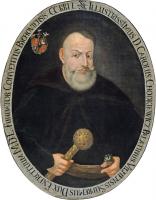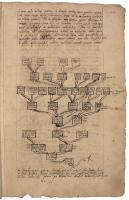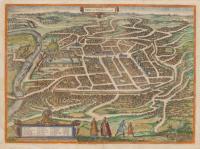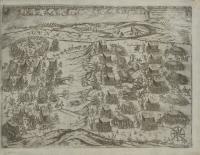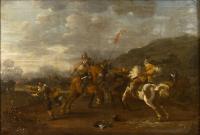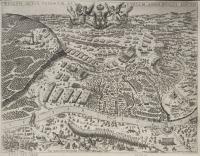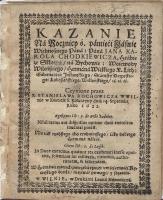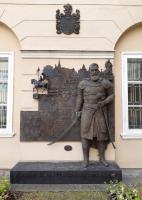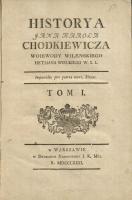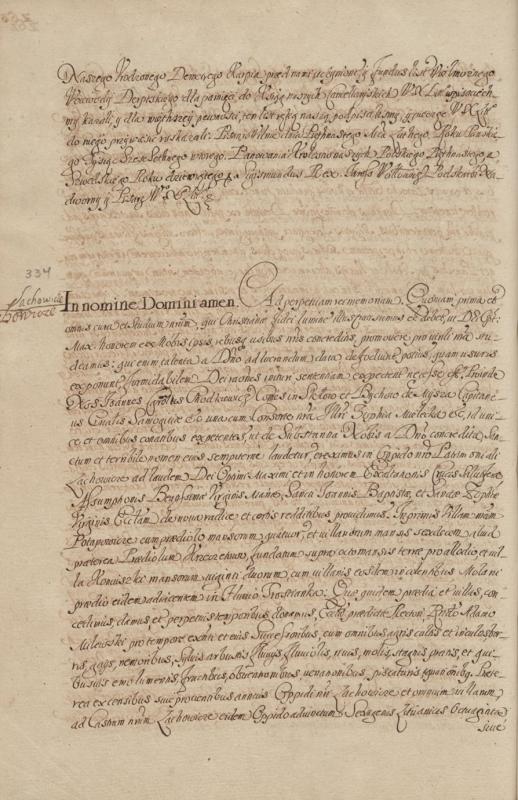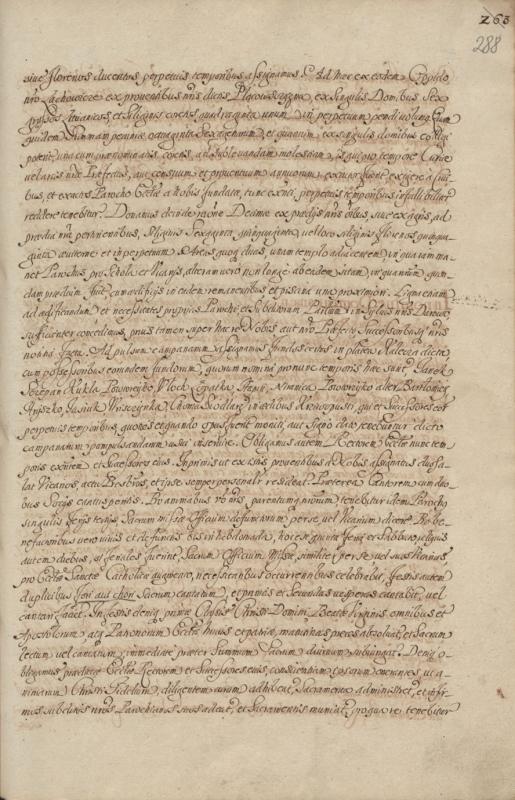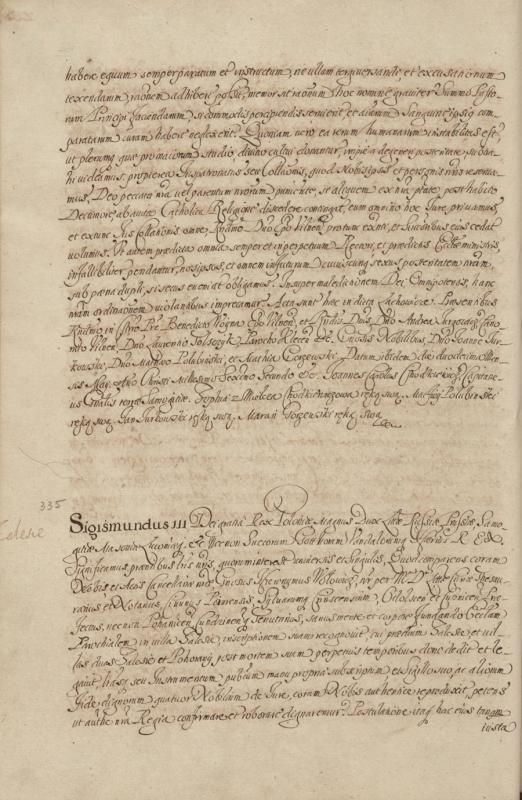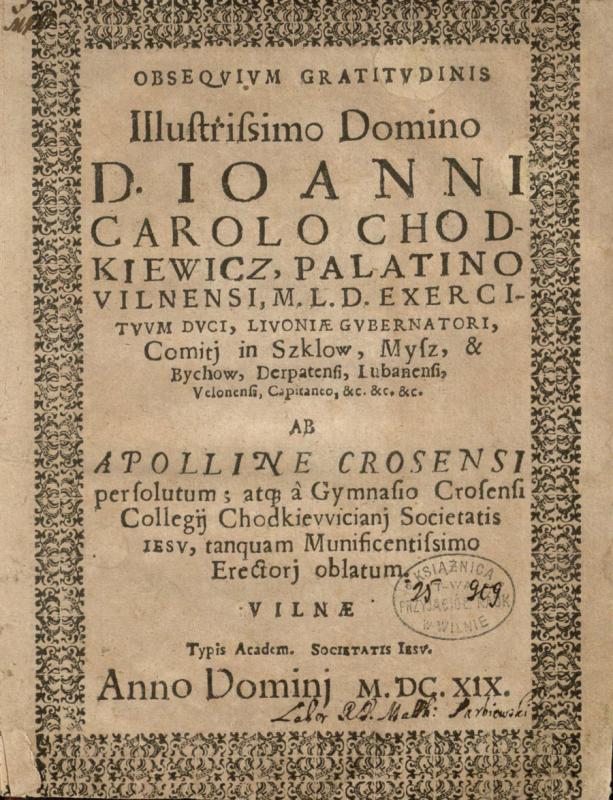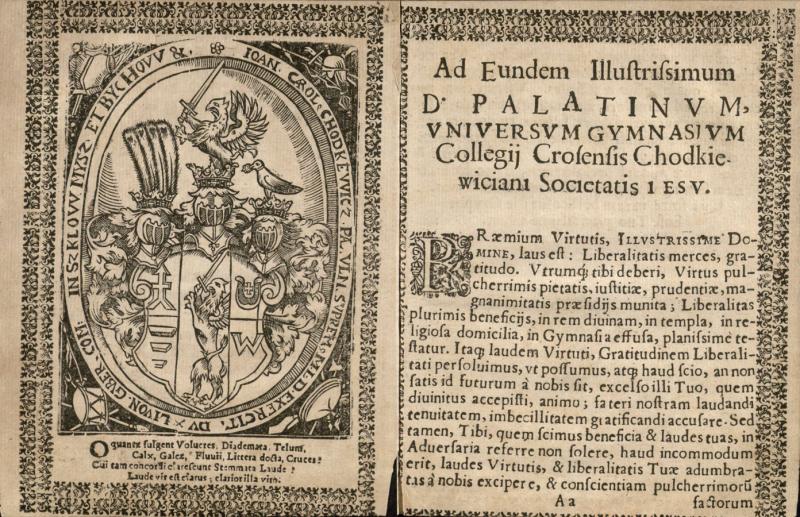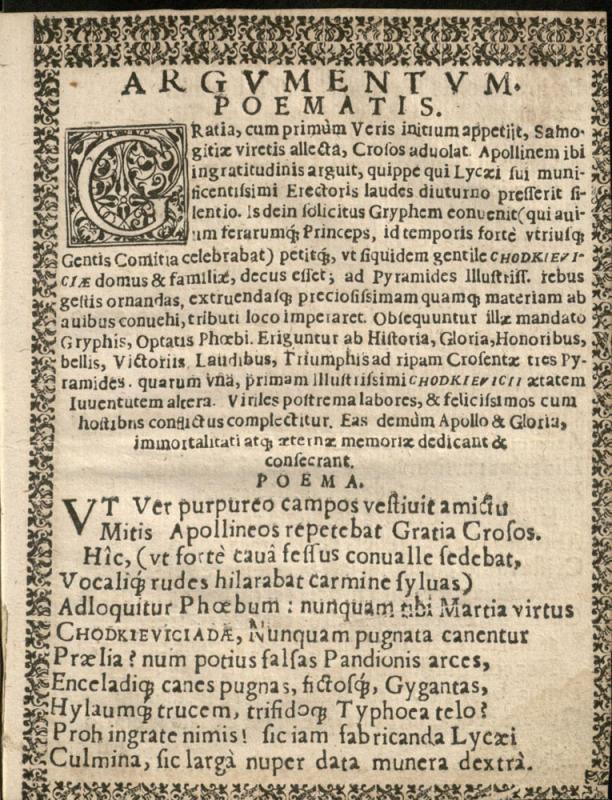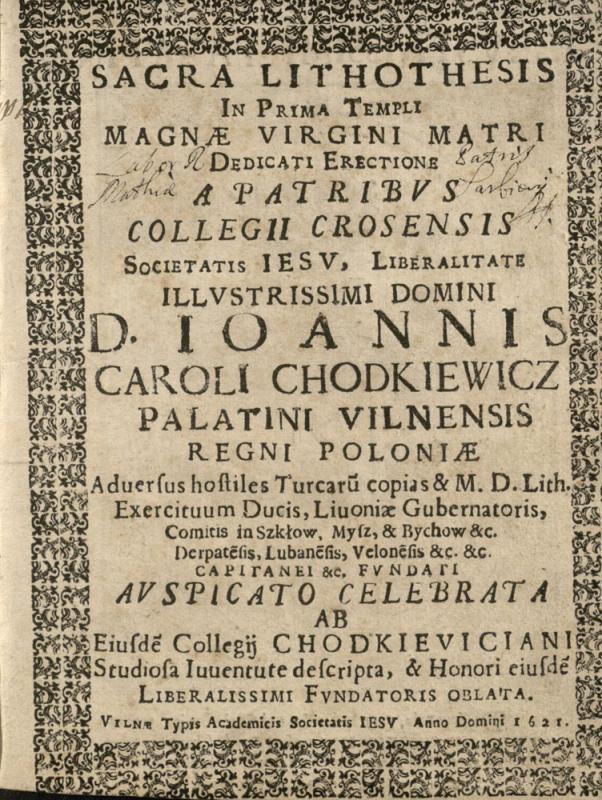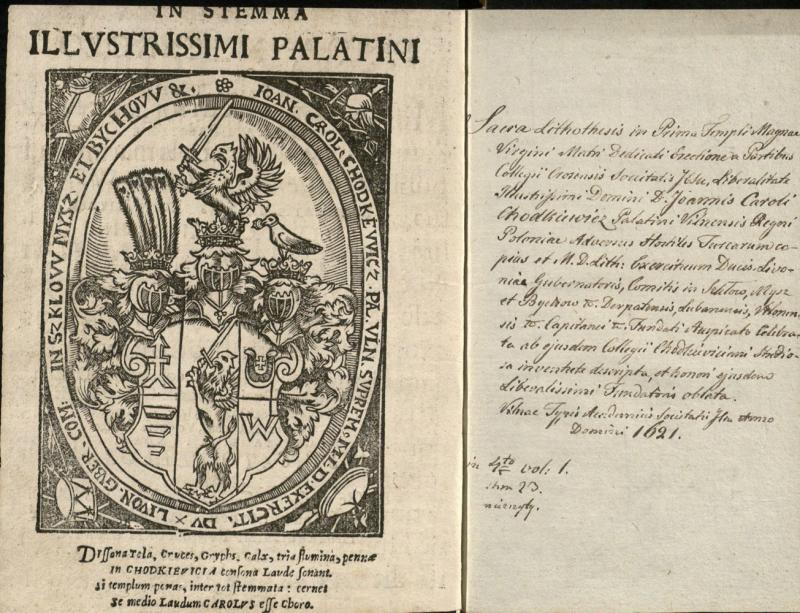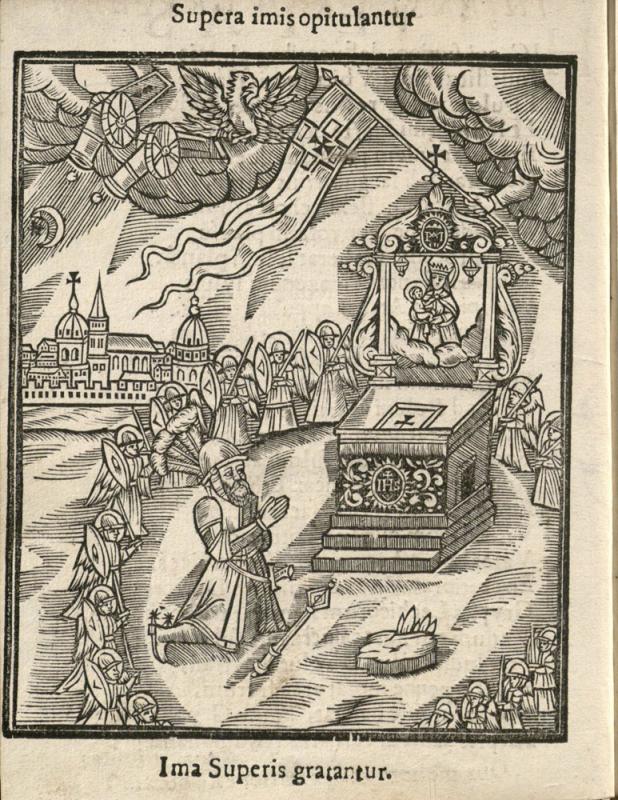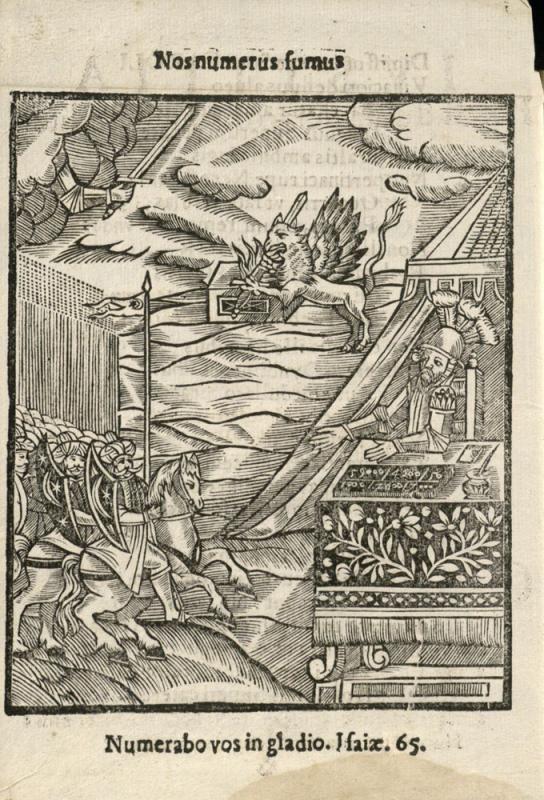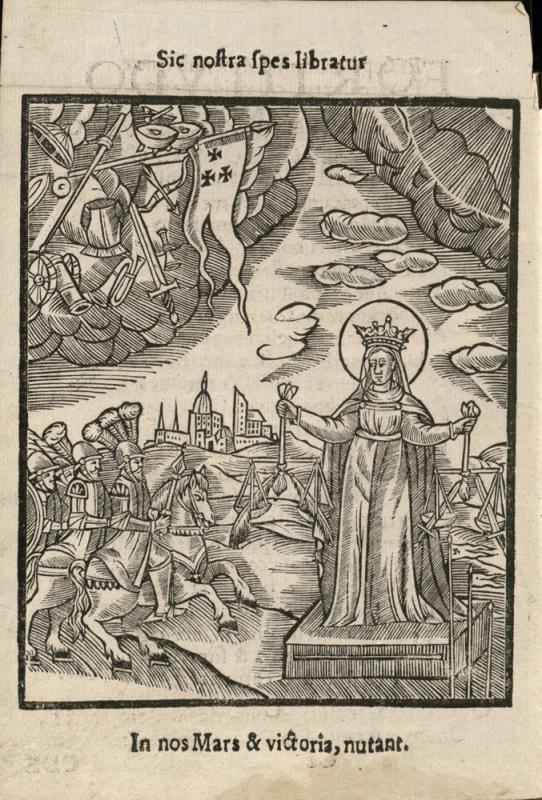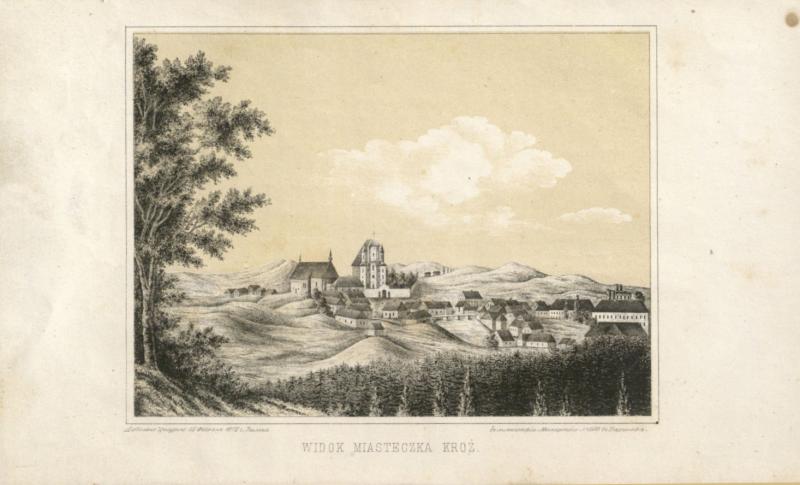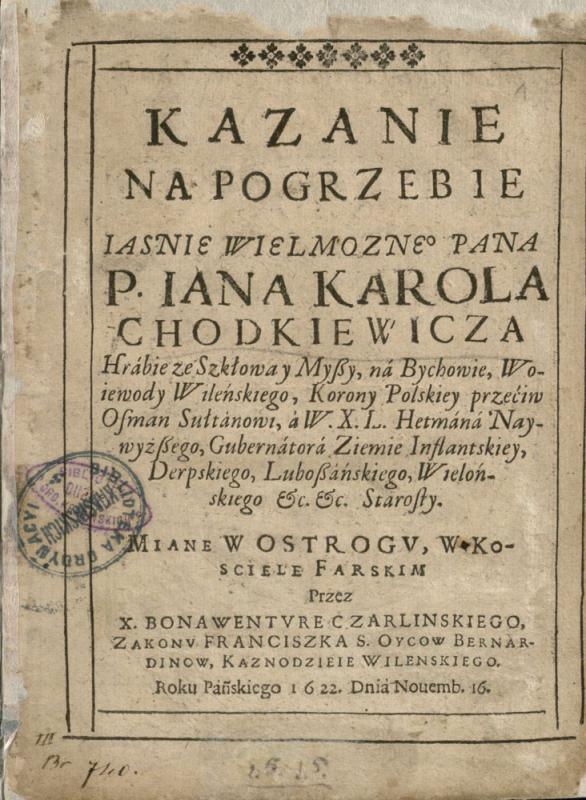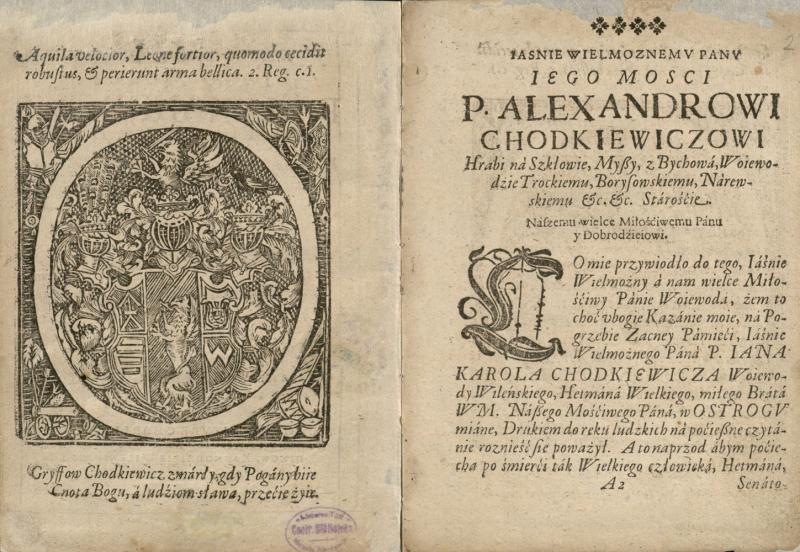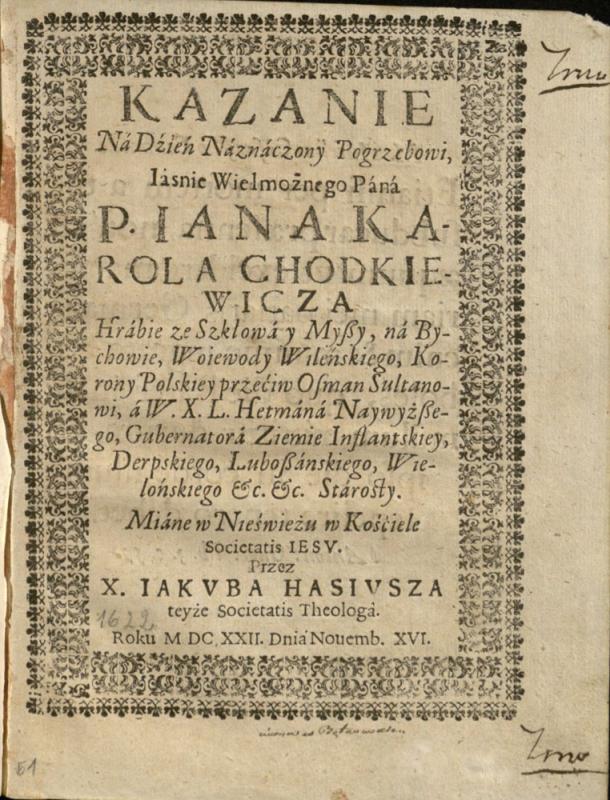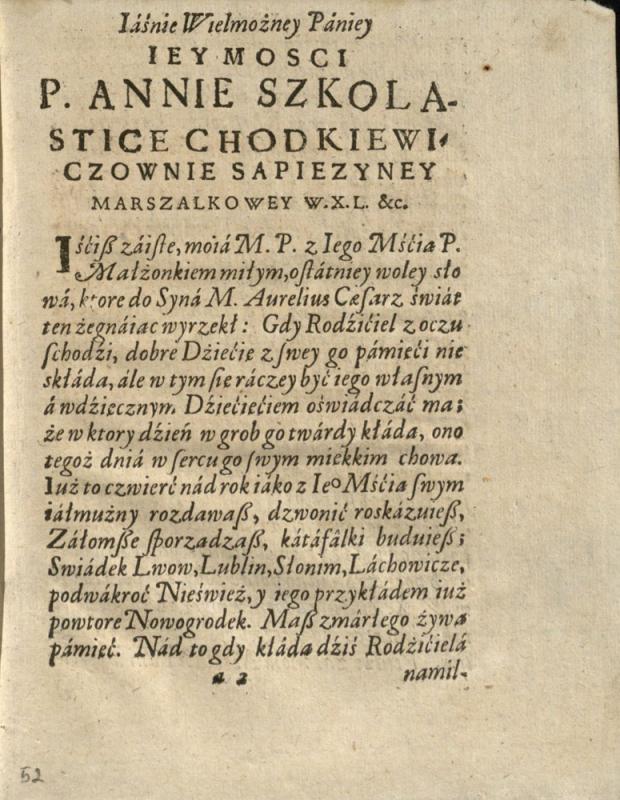Funeral and commemorations. Foundations
After the end of the Khotyn campaign, the commander’s body was buried in Kamianets, and a year later, ceremonially reburied in Olyka. Numerous funerary sermons, poems, and descriptions of paratheatrical events were published to mark this occasion. However, Chodkiewicz was commemorated not only in literature. His memory is preserved in his foundations and buildings constructed by his efforts. In Bykhaw, he built the city’s fortifications, and in 1609‒1619, a new, state of the art, castle. At the same time, Chodkiewicz built an Italian-style bastion fortress and funded the construction of a new Catholic parish church in Liakhavichy. Owing to his efforts and sponsorship, a wooden church was erected in 1602 in Kretinga, on the right bank of the River Akmena. In 1605‒1617, a brick Church of the Annunciation to the Blessed Virgin Mary and St. Francis, as well as a Bernardine monastery were built on the other riverbank. In 1609, Chodkiewicz founded the city of Kretinga and granted it the Magdeburg rights. In 1614, Jan Karol and his wife donated seven farms to the future Kražiai Jesuit College. The cornerstone of the new brick college building was consecrated in 1618. On May 2, 1621, Stanisław Kiszka, Bishop of Samogitia (1584‒1626-02-13) blessed the cornerstone of the Church of the Assumption of the Holy Virgin Mary, which was to be built at the college. The new church building was the most beautiful in Samogitia (unfortunately, it is not extant).
LMAVB RS F43-204, lap. 287v‒288v
This collection of charters includes a transcript of the foundation deed for the Church of the Exaltation of the Holy Cross, Assumption of the Holy Virgin Mary, St. John the Baptist, and St. Sofia issued in Liakhavichy on May 12, 1602. The privilege was granted in the presence of the Bishop of Vilnius, Benediktas Vaina; a Vilnius canon, Andrius Jurgevičius; a parish priest from Kleck, Laurynas Tolscikas; and the noblemen Jonas Jurkovskis, Motiejus Polubinskis, and Motiejus Poževskis. The document was signed by Jan Karol, his wife Sofia, as well as noblemen Jurkovskis, Polubinskis, and Poževskis
Lenkijos nacionalinė biblioteka (Varšuva) XVII.3.15196
“A sermon on the one-year anniversary of the death of the noble Lord of sacred memory, Jan Karol Chodkiewicz” was preached on September 24, 1622 at the church of St. Catherine and published by the Mamonich printing house. In the sermon, dedicated to the commander’s widow, Anna Chodkiewicz, the priest Stanisław Rochowicz discusses special features of a just war, virtues of a Christian warrior, the need for and usefulness of military service. He exalts the deceased, who devotedly defended the homeland and the faith to the end of his life and had all the virtues of a Christian warrior.
LMAVB RSS L-17/35
“Obsequious gratitude to the most illustrious Lord, Jan Karol Chodkiewicz, ... offered by the Apollo of Kražiai” is a collection of prose and poetic works by the Jesuit priest, preacher, and poet Maciej Kazimierz Sarbiewski (1595–1640). Its most important part is a 422-line poem with the plot notable for ingenuity, sophistication and power. The goddess Grace appeals to the Apollo of Kražiai, urging him to give fitting thanks to Chodkiewicz, the founder of the college. At the same time, an animal court is held in Kražiai: King Griffin resolves cases of various birds and beasts. Apollo addresses the King, reminding him of Chodkiewicz’s merits and asking for help: may the King command the animals to travel to their own lands and bring back valuable materials to build a monument. The King does as asked. The birds and beasts hurry to their lands and bring to Kražiai that which is most valuable in those lands. Apollo entreats the Muse of History to begin the construction of the monument. Then he begins playing cithara, and the materials move themselves together to form three pyramids – the monument of gratitude to Chodkiewicz. The fairy tale landscape that harbors gods and goddesses, talking birds and beasts, and other fantastic creatures also contains real-life objects: Medžiokalnis, Šaltinis, the valley of the Kražantė, and the brick walls of the college on the hill behind the river. This might the first poetic image of Kražiai.
LMAVB RSS L-17/35
“Obsequious gratitude to the most illustrious Lord, Jan Karol Chodkiewicz, ... offered by the Apollo of Kražiai” is a collection of prose and poetic works by the Jesuit priest, preacher, and poet Maciej Kazimierz Sarbiewski (1595–1640). This page spread displays the Chodkiewicz coat of arms and the beginning of the dedication from the Kražiai College to Jan Karol Chodkiewicz.
LMAVB RSS L-17/35
“Obsequious gratitude to the most illustrious Lord, Jan Karol Chodkiewicz, ... offered by the Apollo of Kražiai” is a collection of prose and poetic works by the Jesuit priest, preacher, and poet Maciej Kazimierz Sarbiewski (1595–1640). Its most important part is a 422-line poem with the plot notable for ingenuity, sophistication and power. The goddess Grace appeals to the Apollo of Kražiai, urging him to give fitting thanks to Chodkiewicz, the founder of the college. At the same time, an animal court is held in Kražiai: King Griffin resolves cases of birds and beasts. Apollo addresses the King, reminding him of Chodkiewicz’s merits and asking for help: may the King command the animals to travel to their own lands and bring back valuable materials to build a monument. The King does as asked. The birds and beasts hurry to their lands and bring to Kražiai that which is most valuable in those lands. Apollo entreats the Muse of History to begin the construction of the monument. Then he begins playing cithara, and the materials move themselves together to form three pyramids – the monument of gratitude to Chodkiewicz. The fairy tale landscape that harbors gods and goddesses, talking birds and beasts, and other fantastic creatures also contains real-life objects: Medžiokalnis, Šaltinis, the valley of the Kražantė, and the brick walls of the college on the hill behind the river. This might the first poetic image of Kražiai.
LMAVB RSS L-17/98
“The consecration of the cornerstone laid for the erection of a church dedicated to the Great Virgin Mother and funded by the generosity of the most illustrious Lord, Jan Karol Chodkiewicz, ... auspiciously celebrated by the Fathers of the Kražiai College of the Society of Jesus and described by the studying youth of the same Chodkiewicz college” is a collection of occasional poetry by Maciej Kazimierz Sarbiewski (1595–1640). It expands on Chodkiewicz’s four virtues: piety, generosity, fairness, and strength. Each of them is represented by an emblem, explained in two epigrams, and praised in an ode.
LMAVB L-19/594
LMAVB RSS L-17/259
“Sermon on the funeral of the noble Lord Jan Karol Chodkiewicz preached in Ostrog, in the parish church, on the 16th of November in the Lord’s year 1622” by the Bernardine priest Bonawentura Czarliński (circa 1580–1648) is a work on religious and moral issues dedicated to Aleksander, Jan Karol’s brother. It is built around the explanation of the meanings of the main figure in the Chodkiewicz coat of arms, the Griffin (Gryf). Based on the dual nature of the Griffin – the eagle and the lion – the preacher links Jan Karol’s strong faith to the eagle’s eyes, his generosity to the curved beak, and his piety to the wings. The bottom part of the Griffin, that of the King of the Beasts, should be a message to the living that Chodkiewicz is a Lion borne away by Death. This comparison is brought on by Jan Karol’s entire life, that of a virtuous citizen, wise senator and brave warrior; and especially by his victories in Wallachia and Livonia; his foundations in Liakhavichy and Bykhov; his successful negotiations with the Swedes, the Muscovites and the Turks; his triumphs in forcing the Swedes out of Livonia; his defence of Prince Władysław’s right to the throne of the ruler of Moscow; and his repelling of the Turkish and Tatar armies.
LMAVB RSS XVII/241/2
“Sermon on the day designated for the funeral of the noble Lord Jan Karol Chodkiewicz, preached in Nesvizh, in the Church of the Society of Jesus, on the 16th of November, year 1622” by the Jesuit priest and preacher Jakub Hasius is dedicated to the widow, Anna Chodkiewicz. Based on historical, philosophical and theological arguments, the preacher depicts Jan Karol as an ideal Christian warrior and reflects on the loss of such a commander in the face of the disasters that befell the Commonwealth. The preacher condemns spreading heresies, mourns dead soldiers and lost battles, abhors the attacks of the Tatars, bemoans the fate of soldiers and officers taken prisoners and then killed by the Turks. In such circumstances, the death of Jan Karol is felt and shown as a misfortune foretelling the fall of the state. The preacher addresses the daughter of the deceased and urges her and her husband to ensure that the commander’s body be buried in the Grand Duchy, but at the same time mentions that few of the great military leaders were entombed in their homeland. Both Jan Karol’s tomb in Ostrog and his cenotaph in the Nesvizh church will equally serve as a monument to him (monumentum monimentum est). The sermon mentions lesser-known facts of Chodkiewicz’s life, which will later be used by his first biographer, Adomas Stanislovas Naruševičius.

